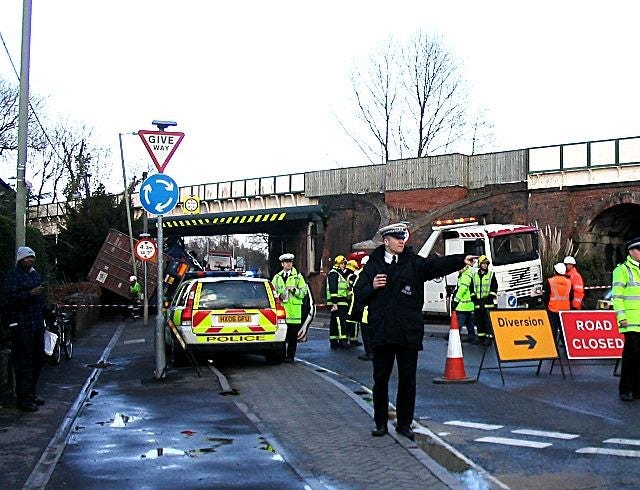Sunday e-mail 25th May: Psychology and driving
Driving laws; road-traffic accidents; attention; cognitive psychology; police vehicles
It is raining heavily. One vehicle overtakes another at 90 mph. The driver loses control, hits a tree, and is killed. The Royal Society for the Prevention of Accidents reports that he’d just received a text message that was three pages long.
This was no isolated incident. Only 8 per cent of the driving population was thought to be using a phone at any one time; nevertheless phone users accounted for 24 per cent of accident victims. Psychologists had established at early as the 1980’s that phone use ad a significant effect on driving performance – even among those who believed themselves immune.
In 2003, it became illegal in the UK to use a hand-held mobile phone while driving.
Attention is one example of what cognitive psychologists call a ‘limited resource’. We have only so much attention to go around and so the more we devote to the person we’re speaking to (or texting with) the less there is left over for operating the steering wheel. Distractions can kill. Worse than that, they can kill other people – innocent people who may not so much as have touched their own phone since they got into the car.
Even safety features can pose a danger. Think of the distracting bleep and flash of your on-board warning buzzers, your handy dashboard lights. Have you ever driven down a road in a town you did not know, and found yourself unable to focus because of the sheer number of signs, lights, beacons, crossings, and road markings? You’re not alone. Road-safety experts know that one way to limit the number of accidents is to limit the engineering. Indeed, the approach is actually called ‘de-engineering’. It means taking the distractions away and leaving a blank canvas of a road behind. The driver is forced to devote attention to what is most important.
MORE FROM CRIME & PSYCHOLOGY:
REMBRANDT, AUTOPSIES, THE SOUL, AND PETTY CRIME
Like most drivers, you probably find that you crash far more often that you’d like into the backs of police vehicles. If my own experienceis anything to go by, a person can barely get to the end of their own driveway without smashing into a jam sandwich, sweat box, or black maria. It’s very frustrating, especially when you’re late for a lecture.
Why does it happen? Why does it keep happening? After all, police vehicles are like Christmas trees on wheels, what with that sparkle, that dazzle, the retro-reflective material. What is it, exactly, that makes them so invisible to the average driver?
You will not be surprised to learn that the answers to all these questions can be learnt on Wednesday, when I’ll be proud to send – straight from my Substack to your inbox – the latest, greatest Crime & Psychology newsletter. It’ll tell you everything you need to know in order not only to astound your friends with insight, but also to avoid those inconvenient car-crashes yourself.
It's remarkable material. I think you’re going to like it. For sure, you’ll learn about some of the most interesting phenomena in Psychology. All that for the price of…well, nothing! Crime & Psychology is and remains free: but of course if you’d like to buy me a coffee, I would not object. Black, please, and filter rather than Nespresso, if it’s all the same to you.
Remember, if you enjoy Crime & Psychology, please share and subscribe. Tell one other person about the Substack!
Free subscriptions make outstanding birthday gifts!
This week’s bullet list features five fascinating facts about human attention:
Ever since the 1940s, psychologists have conceived of human thinking by comparison with computing systems. We refer to ‘symbol-processing models’. The very first were developed by a psychologist named Donald Broadbent, who worked with the RAF and dealt with the problems faced by pilots and air-traffic controllers as they split their attention between various tasks.
Chat with a friend in a noisy room and you might swear that you don’t hear a word that’s said in other, nearby, conversations. But let those strangers say your name, or the word ‘murder’, and you’re likely to be all ears. That shows that you were paying attention even though you didn’t realise it.
Tasks that you perform frequently became ‘automatic’ – which is to say, they come to require no cognitive resources at all. You do them without thinking. Indeed, turn your conscious attention to a task like running downstairs and see where that gets you. Or, better, don’t.
When you read the Crime & Psychology Substack, you are employing a system called ‘sustained attention’. Of course you are – it’s very interesting! You could however turn your attention away, briefly, (however reluctant you may be,) in order to turn up the light or check your diary. Such a simple, everyday phenomenon shows that our attentional system is, at least at times, within our conscious control. Attention is something that we can consciously direct to one or another feature of the world.
Sustained attention can only be maintained for so long. Look at your laptop for, say, half an hour, and you probably need a rest. The best thing to do is to go outside and look at some trees. Trees and other natural phenomena have fractal qualities that distract us and help us relax and become less stressed. Hence a term you may have heard of – ART, or Attentional Restoration Therapy.






I can attest to people hitting cop cars. They seem drawn to the flashing lights. It makes no sense to me.